heater SATURN ION 2007 Owners Manual
[x] Cancel search | Manufacturer: SATURN, Model Year: 2007, Model line: ION, Model: SATURN ION 2007Pages: 440, PDF Size: 2.93 MB
Page 82 of 440
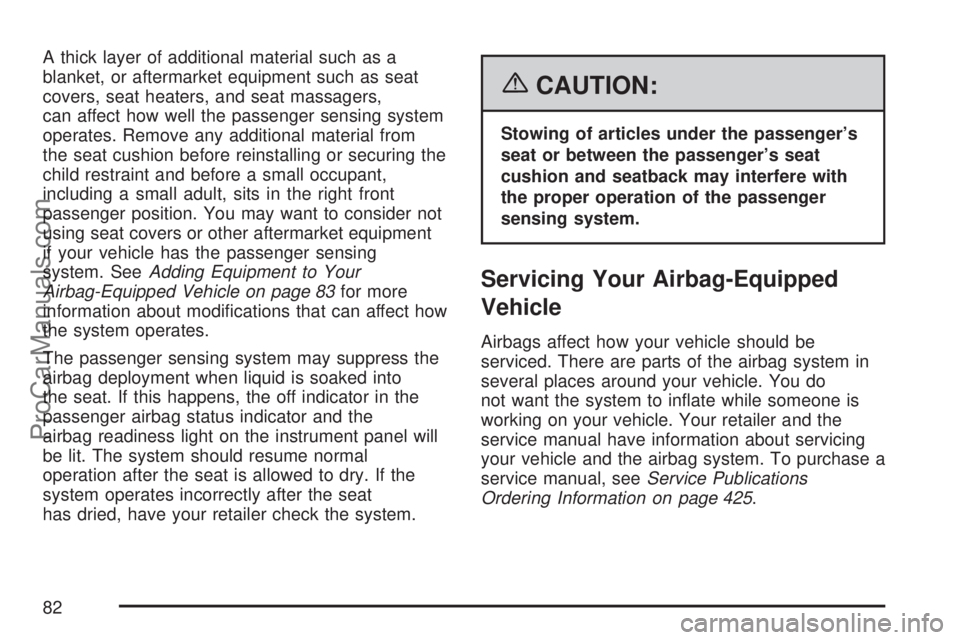
A thick layer of additional material such as a
blanket, or aftermarket equipment such as seat
covers, seat heaters, and seat massagers,
can affect how well the passenger sensing system
operates. Remove any additional material from
the seat cushion before reinstalling or securing the
child restraint and before a small occupant,
including a small adult, sits in the right front
passenger position. You may want to consider not
using seat covers or other aftermarket equipment
if your vehicle has the passenger sensing
system. SeeAdding Equipment to Your
Airbag-Equipped Vehicle on page 83for more
information about modi�cations that can affect how
the system operates.
The passenger sensing system may suppress the
airbag deployment when liquid is soaked into
the seat. If this happens, the off indicator in the
passenger airbag status indicator and the
airbag readiness light on the instrument panel will
be lit. The system should resume normal
operation after the seat is allowed to dry. If the
system operates incorrectly after the seat
has dried, have your retailer check the system.
{CAUTION:
Stowing of articles under the passenger’s
seat or between the passenger’s seat
cushion and seatback may interfere with
the proper operation of the passenger
sensing system.
Servicing Your Airbag-Equipped
Vehicle
Airbags affect how your vehicle should be
serviced. There are parts of the airbag system in
several places around your vehicle. You do
not want the system to in�ate while someone is
working on your vehicle. Your retailer and the
service manual have information about servicing
your vehicle and the airbag system. To purchase a
service manual, seeService Publications
Ordering Information on page 425.
82
ProCarManuals.com
Page 249 of 440
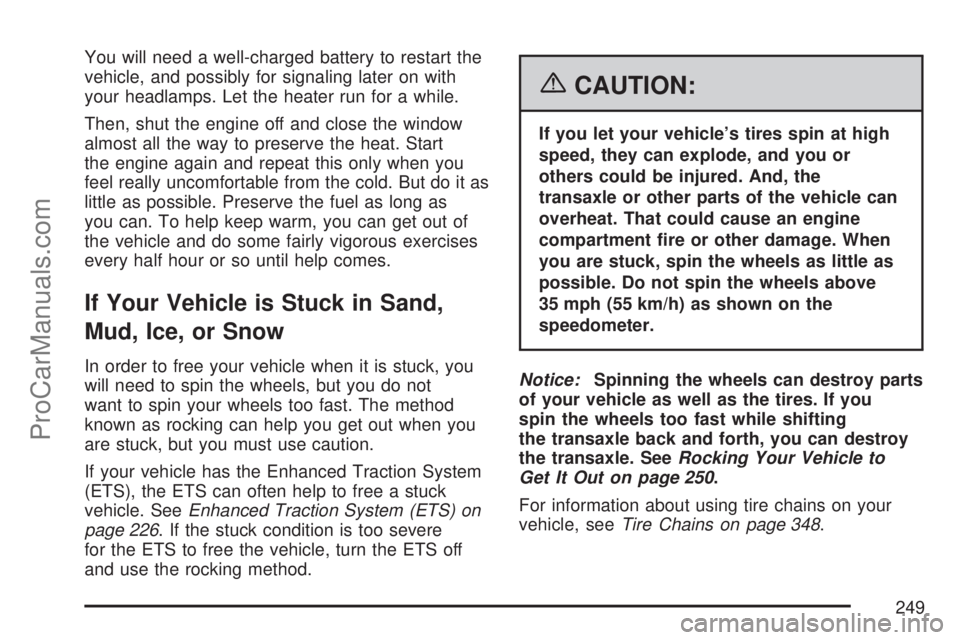
You will need a well-charged battery to restart the
vehicle, and possibly for signaling later on with
your headlamps. Let the heater run for a while.
Then, shut the engine off and close the window
almost all the way to preserve the heat. Start
the engine again and repeat this only when you
feel really uncomfortable from the cold. But do it as
little as possible. Preserve the fuel as long as
you can. To help keep warm, you can get out of
the vehicle and do some fairly vigorous exercises
every half hour or so until help comes.
If Your Vehicle is Stuck in Sand,
Mud, Ice, or Snow
In order to free your vehicle when it is stuck, you
will need to spin the wheels, but you do not
want to spin your wheels too fast. The method
known as rocking can help you get out when you
are stuck, but you must use caution.
If your vehicle has the Enhanced Traction System
(ETS), the ETS can often help to free a stuck
vehicle. SeeEnhanced Traction System (ETS) on
page 226. If the stuck condition is too severe
for the ETS to free the vehicle, turn the ETS off
and use the rocking method.
{CAUTION:
If you let your vehicle’s tires spin at high
speed, they can explode, and you or
others could be injured. And, the
transaxle or other parts of the vehicle can
overheat. That could cause an engine
compartment �re or other damage. When
you are stuck, spin the wheels as little as
possible. Do not spin the wheels above
35 mph (55 km/h) as shown on the
speedometer.
Notice:Spinning the wheels can destroy parts
of your vehicle as well as the tires. If you
spin the wheels too fast while shifting
the transaxle back and forth, you can destroy
the transaxle. SeeRocking Your Vehicle to
Get It Out on page 250.
For information about using tire chains on your
vehicle, seeTire Chains on page 348.
249
ProCarManuals.com
Page 293 of 440
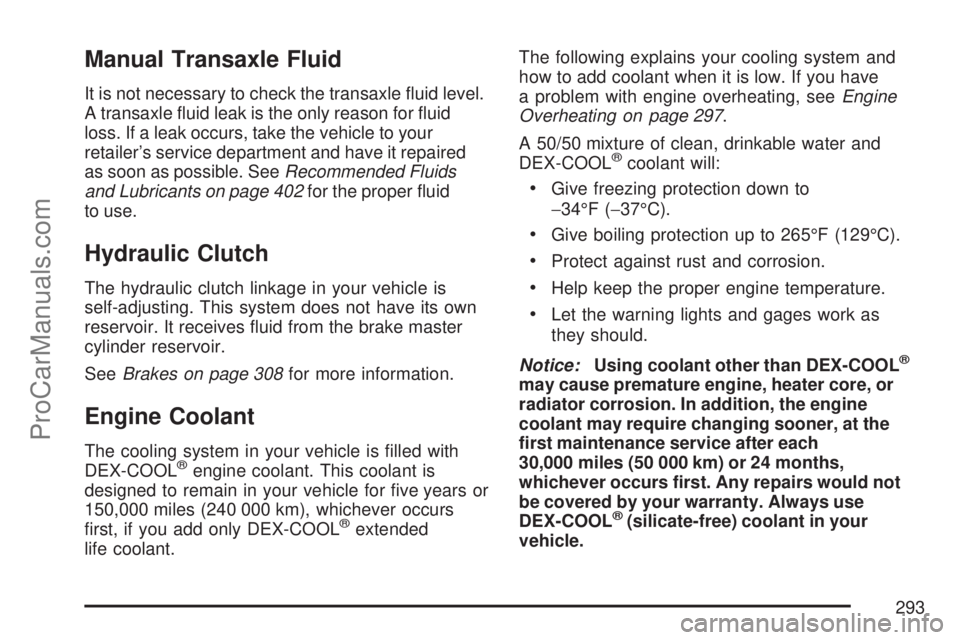
Manual Transaxle Fluid
It is not necessary to check the transaxle �uid level.
A transaxle �uid leak is the only reason for �uid
loss. If a leak occurs, take the vehicle to your
retailer’s service department and have it repaired
as soon as possible. SeeRecommended Fluids
and Lubricants on page 402for the proper �uid
to use.
Hydraulic Clutch
The hydraulic clutch linkage in your vehicle is
self-adjusting. This system does not have its own
reservoir. It receives �uid from the brake master
cylinder reservoir.
SeeBrakes on page 308for more information.
Engine Coolant
The cooling system in your vehicle is �lled with
DEX-COOL®engine coolant. This coolant is
designed to remain in your vehicle for �ve years or
150,000 miles (240 000 km), whichever occurs
�rst, if you add only DEX-COOL
®extended
life coolant.The following explains your cooling system and
how to add coolant when it is low. If you have
a problem with engine overheating, seeEngine
Overheating on page 297.
A 50/50 mixture of clean, drinkable water and
DEX-COOL
®coolant will:
Give freezing protection down to
−34°F (−37°C).
Give boiling protection up to 265°F (129°C).
Protect against rust and corrosion.
Help keep the proper engine temperature.
Let the warning lights and gages work as
they should.
Notice:Using coolant other than DEX-COOL
®
may cause premature engine, heater core, or
radiator corrosion. In addition, the engine
coolant may require changing sooner, at the
�rst maintenance service after each
30,000 miles (50 000 km) or 24 months,
whichever occurs �rst. Any repairs would not
be covered by your warranty. Always use
DEX-COOL
®(silicate-free) coolant in your
vehicle.
293
ProCarManuals.com
Page 294 of 440
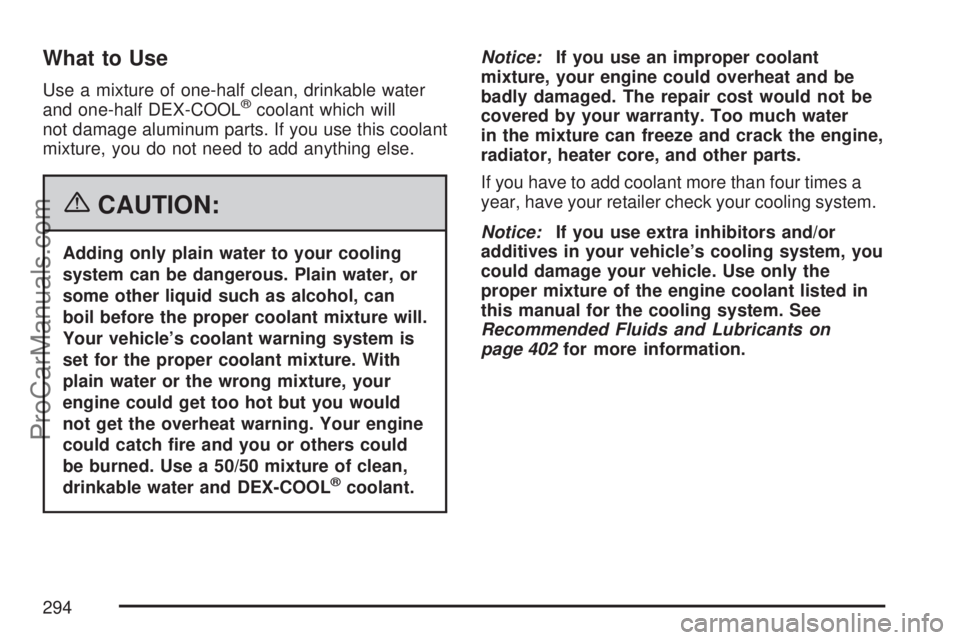
What to Use
Use a mixture of one-half clean, drinkable water
and one-half DEX-COOL®coolant which will
not damage aluminum parts. If you use this coolant
mixture, you do not need to add anything else.
{CAUTION:
Adding only plain water to your cooling
system can be dangerous. Plain water, or
some other liquid such as alcohol, can
boil before the proper coolant mixture will.
Your vehicle’s coolant warning system is
set for the proper coolant mixture. With
plain water or the wrong mixture, your
engine could get too hot but you would
not get the overheat warning. Your engine
could catch �re and you or others could
be burned. Use a 50/50 mixture of clean,
drinkable water and DEX-COOL
®coolant.Notice:If you use an improper coolant
mixture, your engine could overheat and be
badly damaged. The repair cost would not be
covered by your warranty. Too much water
in the mixture can freeze and crack the engine,
radiator, heater core, and other parts.
If you have to add coolant more than four times a
year, have your retailer check your cooling system.
Notice:If you use extra inhibitors and/or
additives in your vehicle’s cooling system, you
could damage your vehicle. Use only the
proper mixture of the engine coolant listed in
this manual for the cooling system. See
Recommended Fluids and Lubricants on
page 402for more information.
294
ProCarManuals.com
Page 299 of 440
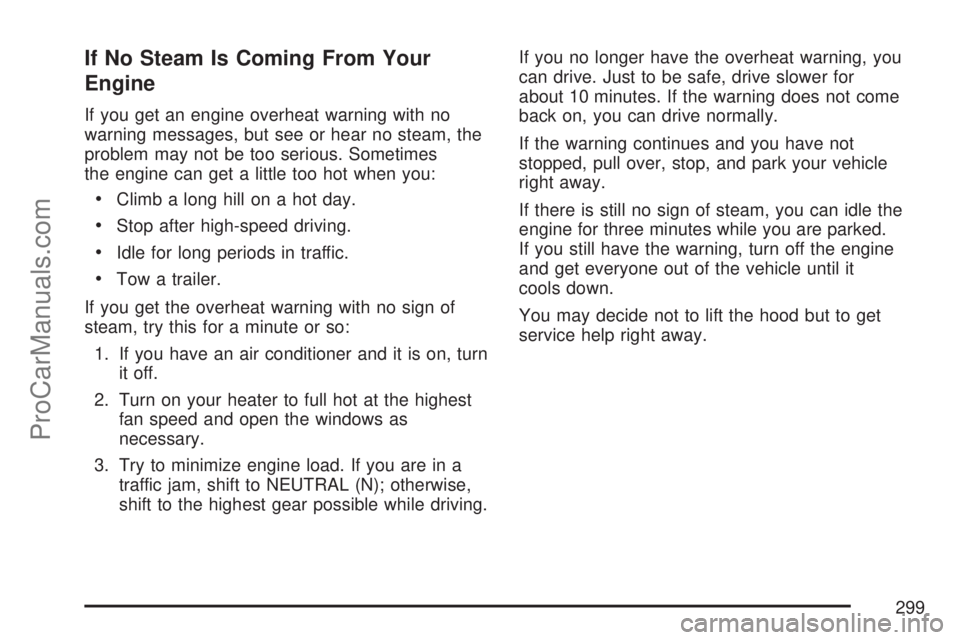
If No Steam Is Coming From Your
Engine
If you get an engine overheat warning with no
warning messages, but see or hear no steam, the
problem may not be too serious. Sometimes
the engine can get a little too hot when you:
Climb a long hill on a hot day.
Stop after high-speed driving.
Idle for long periods in traffic.
Tow a trailer.
If you get the overheat warning with no sign of
steam, try this for a minute or so:
1. If you have an air conditioner and it is on, turn
it off.
2. Turn on your heater to full hot at the highest
fan speed and open the windows as
necessary.
3. Try to minimize engine load. If you are in a
traffic jam, shift to NEUTRAL (N); otherwise,
shift to the highest gear possible while driving.If you no longer have the overheat warning, you
can drive. Just to be safe, drive slower for
about 10 minutes. If the warning does not come
back on, you can drive normally.
If the warning continues and you have not
stopped, pull over, stop, and park your vehicle
right away.
If there is still no sign of steam, you can idle the
engine for three minutes while you are parked.
If you still have the warning, turn off the engine
and get everyone out of the vehicle until it
cools down.
You may decide not to lift the hood but to get
service help right away.
299
ProCarManuals.com
Page 300 of 440
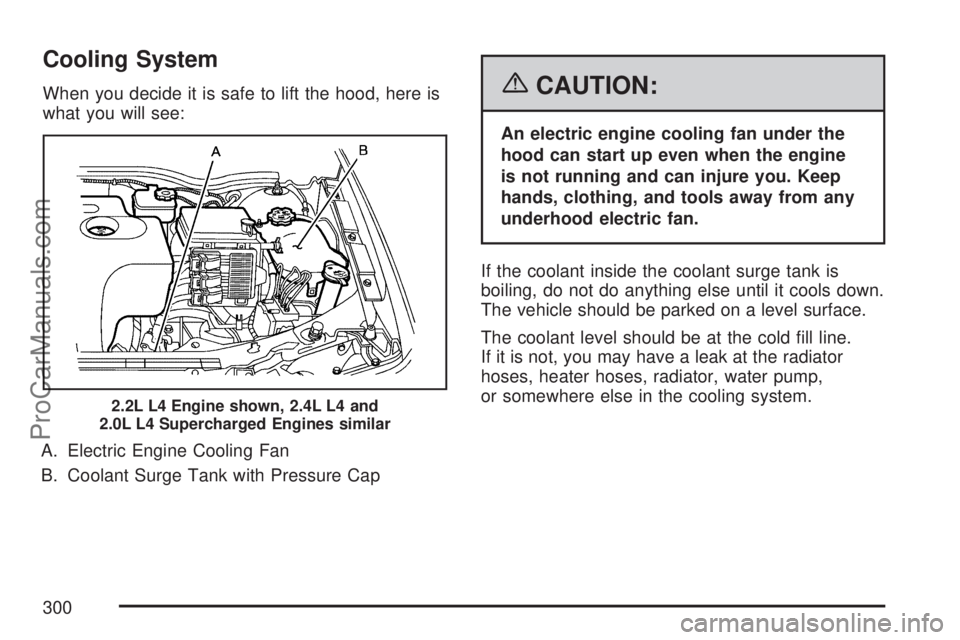
Cooling System
When you decide it is safe to lift the hood, here is
what you will see:
A. Electric Engine Cooling Fan
B. Coolant Surge Tank with Pressure Cap{CAUTION:
An electric engine cooling fan under the
hood can start up even when the engine
is not running and can injure you. Keep
hands, clothing, and tools away from any
underhood electric fan.
If the coolant inside the coolant surge tank is
boiling, do not do anything else until it cools down.
The vehicle should be parked on a level surface.
The coolant level should be at the cold �ll line.
If it is not, you may have a leak at the radiator
hoses, heater hoses, radiator, water pump,
or somewhere else in the cooling system.
2.2L L4 Engine shown, 2.4L L4 and
2.0L L4 Supercharged Engines similar
300
ProCarManuals.com
Page 301 of 440

{CAUTION:
Heater and radiator hoses, and other
engine parts, can be very hot. Do not
touch them. If you do, you can be burned.
Do not run the engine if there is a leak.
If you run the engine, it could lose all
coolant. That could cause an engine �re,
and you could be burned. Get any leak
�xed before you drive the vehicle.
If there seems to be no leak, with the engine on,
check to see if the electric engine cooling fan
is running. If the engine is overheating, the
fan should be running. If it is not, your vehicle
needs service. Turn off the engine.Notice:Engine damage from running your
engine without coolant is not covered by
your warranty.
Notice:Using coolant other than DEX-COOL®
may cause premature engine, heater core,
or radiator corrosion. In addition, the engine
coolant could require changing sooner, at
30,000 miles (50 000 km) or 24 months,
whichever occurs �rst. Any repairs would
not be covered by your warranty. Always
use DEX-COOL
®(silicate-free) coolant in
your vehicle.
301
ProCarManuals.com
Page 303 of 440
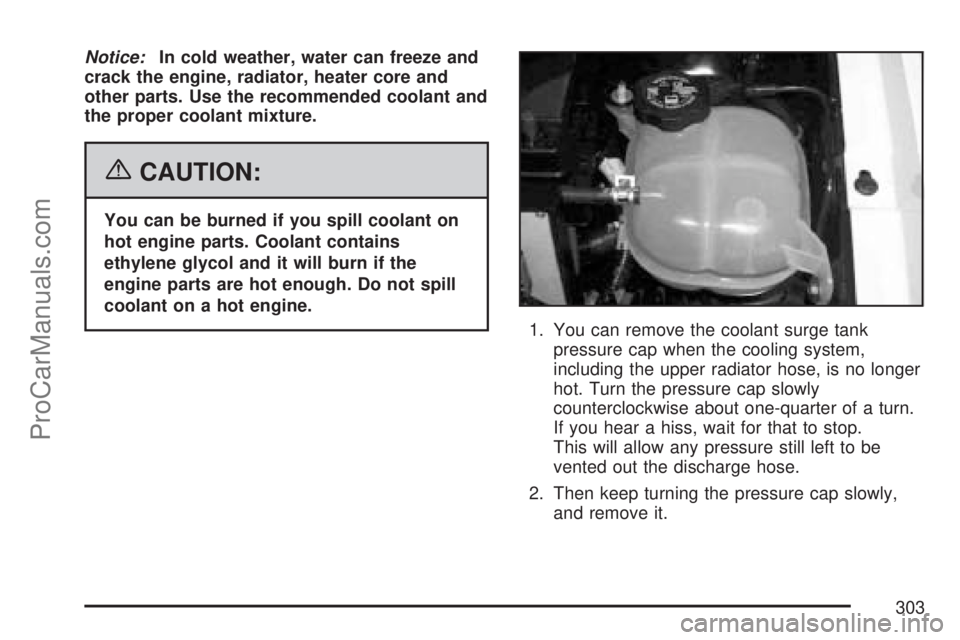
Notice:In cold weather, water can freeze and
crack the engine, radiator, heater core and
other parts. Use the recommended coolant and
the proper coolant mixture.
{CAUTION:
You can be burned if you spill coolant on
hot engine parts. Coolant contains
ethylene glycol and it will burn if the
engine parts are hot enough. Do not spill
coolant on a hot engine.
1. You can remove the coolant surge tank
pressure cap when the cooling system,
including the upper radiator hose, is no longer
hot. Turn the pressure cap slowly
counterclockwise about one-quarter of a turn.
If you hear a hiss, wait for that to stop.
This will allow any pressure still left to be
vented out the discharge hose.
2. Then keep turning the pressure cap slowly,
and remove it.
303
ProCarManuals.com
Page 305 of 440
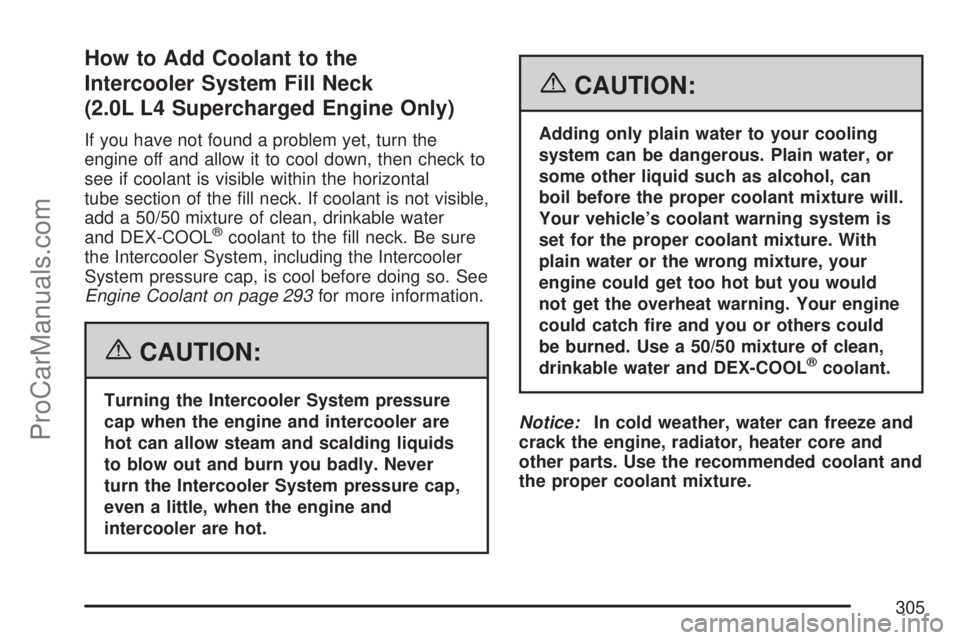
How to Add Coolant to the
Intercooler System Fill Neck
(2.0L L4 Supercharged Engine Only)
If you have not found a problem yet, turn the
engine off and allow it to cool down, then check to
see if coolant is visible within the horizontal
tube section of the �ll neck. If coolant is not visible,
add a 50/50 mixture of clean, drinkable water
and DEX-COOL
®coolant to the �ll neck. Be sure
the Intercooler System, including the Intercooler
System pressure cap, is cool before doing so. See
Engine Coolant on page 293for more information.
{CAUTION:
Turning the Intercooler System pressure
cap when the engine and intercooler are
hot can allow steam and scalding liquids
to blow out and burn you badly. Never
turn the Intercooler System pressure cap,
even a little, when the engine and
intercooler are hot.
{CAUTION:
Adding only plain water to your cooling
system can be dangerous. Plain water, or
some other liquid such as alcohol, can
boil before the proper coolant mixture will.
Your vehicle’s coolant warning system is
set for the proper coolant mixture. With
plain water or the wrong mixture, your
engine could get too hot but you would
not get the overheat warning. Your engine
could catch �re and you or others could
be burned. Use a 50/50 mixture of clean,
drinkable water and DEX-COOL
®coolant.
Notice:In cold weather, water can freeze and
crack the engine, radiator, heater core and
other parts. Use the recommended coolant and
the proper coolant mixture.
305
ProCarManuals.com
Page 432 of 440
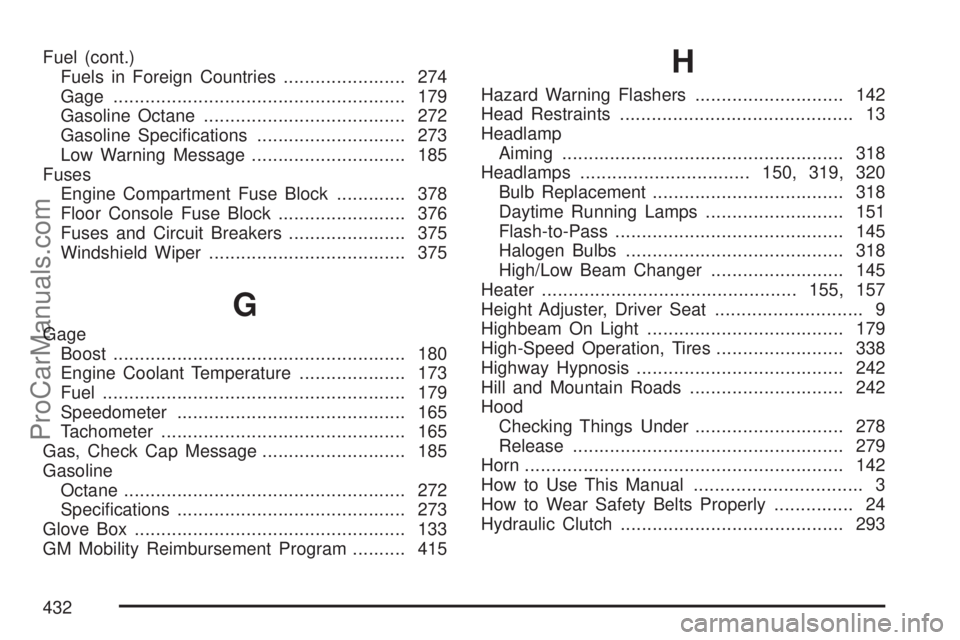
Fuel (cont.)
Fuels in Foreign Countries....................... 274
Gage....................................................... 179
Gasoline Octane...................................... 272
Gasoline Speci�cations............................ 273
Low Warning Message............................. 185
Fuses
Engine Compartment Fuse Block............. 378
Floor Console Fuse Block........................ 376
Fuses and Circuit Breakers...................... 375
Windshield Wiper..................................... 375
G
Gage
Boost....................................................... 180
Engine Coolant Temperature.................... 173
Fuel......................................................... 179
Speedometer........................................... 165
Tachometer.............................................. 165
Gas, Check Cap Message........................... 185
Gasoline
Octane..................................................... 272
Speci�cations........................................... 273
Glove Box................................................... 133
GM Mobility Reimbursement Program.......... 415
H
Hazard Warning Flashers............................ 142
Head Restraints............................................ 13
Headlamp
Aiming..................................................... 318
Headlamps................................150, 319, 320
Bulb Replacement.................................... 318
Daytime Running Lamps.......................... 151
Flash-to-Pass........................................... 145
Halogen Bulbs......................................... 318
High/Low Beam Changer ......................... 145
Heater................................................155, 157
Height Adjuster, Driver Seat............................ 9
Highbeam On Light..................................... 179
High-Speed Operation, Tires........................ 338
Highway Hypnosis....................................... 242
Hill and Mountain Roads............................. 242
Hood
Checking Things Under............................ 278
Release................................................... 279
Horn............................................................ 142
How to Use This Manual................................ 3
How to Wear Safety Belts Properly............... 24
Hydraulic Clutch.......................................... 293
432
ProCarManuals.com